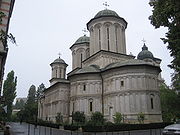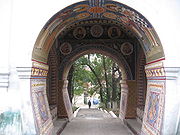
Radu Voda Monastery
Encyclopedia
Paleolithic
Because of its favorable environment and the elevated terrain close to a big river, the area of the monastery was inhabited starting from the PaleolithicPaleolithic
The Paleolithic Age, Era or Period, is a prehistoric period of human history distinguished by the development of the most primitive stone tools discovered , and covers roughly 99% of human technological prehistory...
(estimated somewhere between 1,000,000 and 10,000 BC). It is the site of the oldest known settlement on the territory of Romania. Following the Paleolithic settlement there was an uninterrupted settlement during the Neolithic
Neolithic
The Neolithic Age, Era, or Period, or New Stone Age, was a period in the development of human technology, beginning about 9500 BC in some parts of the Middle East, and later in other parts of the world. It is traditionally considered as the last part of the Stone Age...
with tools from the Neolithic, the bronze age
Bronze Age
The Bronze Age is a period characterized by the use of copper and its alloy bronze as the chief hard materials in the manufacture of some implements and weapons. Chronologically, it stands between the Stone Age and Iron Age...
(1800-800 BC), and the iron age
Iron Age
The Iron Age is the archaeological period generally occurring after the Bronze Age, marked by the prevalent use of iron. The early period of the age is characterized by the widespread use of iron or steel. The adoption of such material coincided with other changes in society, including differing...
(800 BC - AD 300).
The Dacian Era
The monastery is also the site of the remains of a fortified settlement from the Dacian EraDacia
In ancient geography, especially in Roman sources, Dacia was the land inhabited by the Dacians or Getae as they were known by the Greeks—the branch of the Thracians north of the Haemus range...
(100 BC - AD 100).
History of the Monastery
The monastery was founded by Alexandru II MirceaAlexandru II Mircea
Alexandru II Mircea was Hospodar of Wallachia from 1568 to 1574 and 1574 to 1577. He was the father of Mihnea II Turcitul. His parents were Mircea III Dracul and Maria Despina...
(1568-1577) and his lady Ecaterina (Catherine) to give thanks for their victory in battle. It was intended to be the metropolitan church
Metropolis (religious jurisdiction)
A metropolis is a see or city whose bishop is the metropolitan of a province. Metropolises, historically, have been important cities in their provinces....
of the capital. The monastery was completely renovated during 1969-1974, on the initiative of patriarch Justinian Marina
Justinian Marina
Justinian Marina was a Romanian Orthodox prelate...
. Upon his death in 1977, the patriach was laid to rest in a grave in the interior wall of the monastery.
Location
Located at Radu Vodă str., no. 24A on the banks of Dâmboviţa RiverDâmbovita River
Dâmbovița is a river in Romania. It has its sources in the Făgăraş Mountains, on the Curmătura Oticu. The upper reach of the rivers, upstream of the confluence with the Boarcăşu River is also known as Izvorul Oticului River or Oticu River....
and close to the Romanian Patriarchal
Patriarchate
A patriarchate is the office or jurisdiction of a patriarch. A patriarch, as the term is used here, is either* one of the highest-ranking bishops in Eastern Orthodoxy, earlier, the five that were included in the Pentarchy: Rome, Constantinople, Alexandria, Antioch, and Jerusalem, but now nine,...
Cathedral, the Monastery is located right in the middle of Bucharest, the capital of Romania. It is a few hundred meters away from the exit of Piaţa Unirii metro station
Piata Unirii metro station
Piața Unirii is a major metro station in Bucharest. It is located in the southern part of the city centre, in Unirii Square and it is one of the busiest stations of the Bucharest Metro...
.
Gallery



